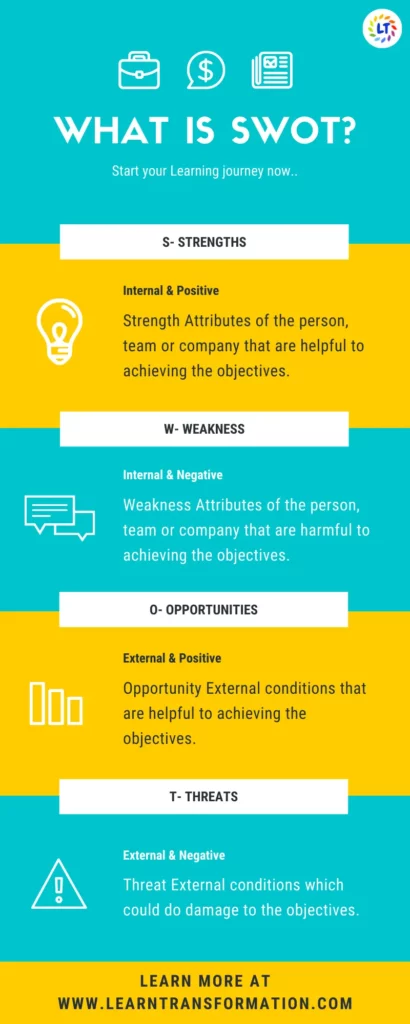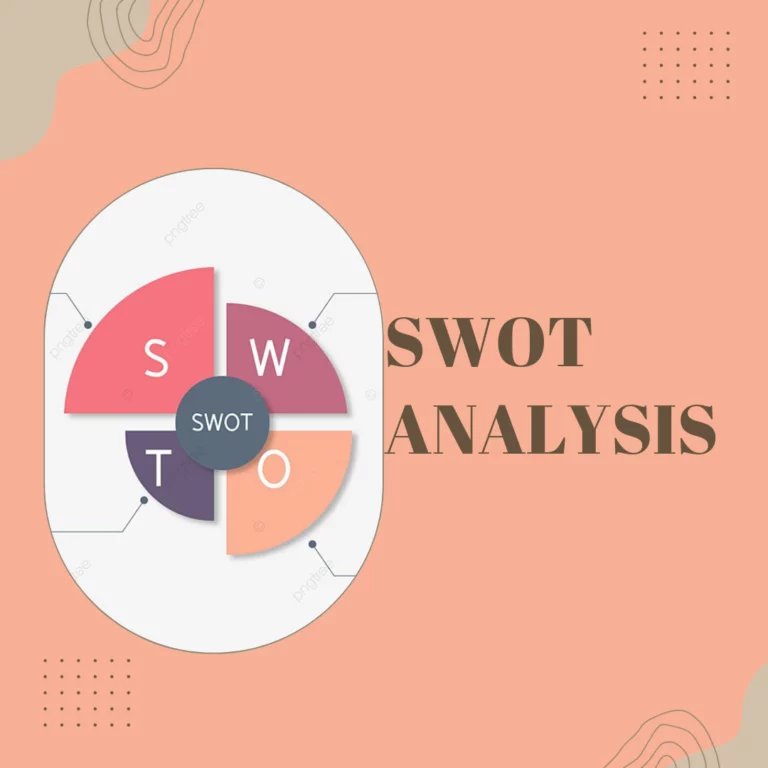“Leadership is the art of giving people a platform for spreading ideas that work.” ~ Seth Godin
Maintaining competitiveness and attaining sustainable growth are ongoing challenges in the fast-paced and dynamic business environment. Thus, organisations need a strategic tool that can offer insights for decision-making to manage this dynamic environment. Introducing SWOT analysis, a potent framework that has long been a pillar of strategic planning.
SWOT, an acronym for Strengths, Weaknesses, Opportunities, and Threats, is a compass that directs enterprises towards their objectives. In this blog, we will delve deep into SWOT analysis, revealing its complexities and showing how this adaptable technique can be used.
Understanding and properly utilising SWOT analysis is crucial whether you’re an established market leader trying to keep your edge or a beginning entrepreneur trying to make your mark. Moreover, come along on this adventure as we explore the world of SWOT analysis and show you how it may enable you to make wise decisions, seize opportunities, and set yourself up for success in today’s cutthroat business environment.
What is SWOT Analysis?
Organisations utilise SWOT analysis, a strategic planning tool, to analyse their internal strengths and weaknesses as well as external opportunities and threats. Furthermore, it aids in the formulation of growth and success strategies for an organization’s future by giving a thorough overview of the existing state of the business. Here is a thorough breakdown of each element of the SWOT analysis:
Strengths (internal):
- Further, the internal qualities and resources that provide a company a competitive edge on the market are called strengths.
- Moreover, these may consist of knowledgeable and driven staff, exclusive intellectual property or technology, a well-known brand, effective business procedures, and a committed clientele.
- Strengths are something that an organisation excels at and may use to further its goals.
Weakness (Internal):
- Internal problems, or weaknesses, are what prevent an organisation from doing well or competing effectively.
- Additionally, these may consist of scarce financial resources, outmoded technology, insufficient employee development, ineffective procedures, or subpar management techniques.
- Thus, understanding your weaknesses will help you confront and remove internal barriers to achievement.
Opportunities (external):
- Opportunities are variables and trends in the external business environment that a company can take advantage of.
- Moreover, emerging markets, shifting customer preferences, technological developments, or favourable economic conditions are a few examples of opportunities.
- Thus, recognising opportunities enables businesses to take advantage of fresh chances for development and expansion.
Threats (external):
- External forces that have the ability to harm or interfere with an organization’s activities and objectives are called threats.
- Furthermore, economic downturns, fierce rivalry, alterations in the law, natural calamities, or changes in consumer behaviour are a few examples.
- Thus, organisations can better plan for and handle future problems by identifying threats.
Also Read: Digital Transformation: The Key to Effective Digital Strategy

The SWOT analysis process gathers information and data regarding each of these four components. Frequently, research, surveys, internal evaluations, and market analysis are used to get this data. After the information is gathered, it is arranged into a SWOT matrix, which graphically illustrates the correlations between components.
Also read: Digital Transformation Strategy, Framework And Tools
The SWOT analysis allows organisations to:
- Utilise possibilities by building on their strengths.
- To improve their market positioning, address deficiencies.
- Use your advantages to neutralise or reduce dangers.
- Create plans of action to overcome the obstacles vulnerabilities and outside threats present.
In order to take into account changes in the internal and external business environment, SWOT analysis is a dynamic tool that should be reviewed on a regular basis. It acts as the basis for goal-setting, strategic planning, and decision-making, assisting organisations in making adjustments to changing conditions and achieving long-term success.
Leader’s Tip
Ensure that your SWOT analysis covers all relevant aspects of your business, including internal and external factors.
How to Use SWOT Analysis for Business Growth?
A systematic approach of evaluating an organization’s internal strengths and weaknesses as well as external opportunities and threats is required when using SWOT analysis for business growth. Here is a thorough description of how to utilise SWOT analysis to grow your business:
Obtain Information
Start by gathering pertinent information and statistics. This includes market analysis, financial data and any other data sources that shed light on the health of your company at the moment.
Internal evaluation
- Strengths (S)
- Determine the internal elements that provide your company a competitive advantage.
- Take into account elements like knowledgeable, distinctive goods or services, a solid brand recognition, effective procedures, and stable finances.
- What does the organisation excel at, for example? What distinguishes us from our rivals?
2. Weakness (W):
- Recognise the internal issues affecting your company’s performance.
- Consider factors like limited resources, outmoded technology, low employee morale, or ineffective procedures.
- What are our operational challenges, for instance? Where do we need to get better?
Outside Analysis:
- Opportunties (O):
- Consider developments in the business climate and external factors that can be advantageous to your company.
- Consider market expansion, new technologies, shifting customer preferences, and governmental changes.
- Consider asking: What market trends can we take advantage of? Exist unrealized potential in our sector?
2. Risks (T):
- Determine the outside elements that could endanger or complicate your business.
- Take into account elements like financial crises, heightened competition, legal restrictions, or changing consumer behaviour.
- Ask yourself things like: What outside forces might be harmful to our company? SWOT analysis
To visually depict the four categories (Strengths, Weaknesses, Opportunities, and Threats), create a SWOT matrix or chart.
To give a clear picture of the internal and external environment of your organisation, group the detected components into the appropriate categories.
Leader’s Tip
Involve key stakeholders, employees, and department heads in the SWOT analysis process.
Strategic Planning:
- Also, create strategies that take advantage of strengths, address weaknesses, seize opportunities, and reduce risks based on the SWOT analysis.
- For instance, if you see a market opportunity and a strength in the shape of skilled employees, your strategy might be to increase your market presence with the aid of your professional workforce.
Action Strategy:
- Specify the precise actions, deadlines, and roles involved in putting the strategy created in the previous stage into practise.
- Thus, make sure each approach has a clear execution plan.
Watch and Examine:
- As the business environment changes, periodically review and update the SWOT analysis and the associated strategy.
- Additionally, to assess the success of your initiatives and make the required modifications, use key performance indicators (KPIs).
The continual practise of using SWOT analysis for corporate growth aids organisations in decision-making, resource alignment, and opportunity exploitation while minimising risks. Furthermore, it provides a useful foundation for strategic planning and guarantees that the organisation will continue to be flexible and responsive to changing market conditions. Thus, SWOT analysis serves as a guiding light, illuminating the road to success and progress in the field of corporate strategy. As our investigation of this effective tool comes to a close, it is plainly evident that SWOT is more than just an acronym; it is a dynamic tool that enables organisations to prosper in a continuously changing environment.
SWOT can be used to build organizational & personal strategy.
Firstly, Learn Transformation is dedicated to fostering the growth of more transformational leaders across all sectors of society in the current VUCA world. So, In this article, we mention some books and videos regarding SWOT.
We guarantee that you will have access to top-notch learning opportunities on all transformational topics, including leadership transformation, business transformation, digital transformation, strategy transformation, quality transformation, operational transformation, supply chain transformation, human resources transformation, financial transformation, lean transformation, and also many others.
The Best Books About SWOT
Global Reader’s Click Below:
- The SWOT Analysis: Using your Strength to overcome Weaknesses, Using Opportunities to overcome Threats
- SWOT Analysis Log Book
- SWOT Analysis of a Person: Notebook for Assessing a Person’s Strengths, Weaknesses, Opportunities, and Threats
- SWOT Analysis Business Poster – Laminated – 33” x 23.5” – Educational School and Classroom Posters
India Reader’s Click below:
- SWOT-Analyse am Beispiel McFit
- The SWOT Analysis: A key tool for developing your business strategy (Management & Marketing Book 21)
- SWOT: Law of Evidence
- Swot Analysis: A Guide..Business Studies Students
Conclusion
We have seen how an organization’s internal Strengths and Weaknesses serve as the cornerstone of its strategic basis through the perspective of SWOT analysis. We’ve seen how external Opportunities and Threats create a panorama of options and difficulties that, when skillfully negotiated, might be the difference between success and failure. Moreover, SWOT analysis’s versatility, which enables it to be used by companies of all sizes, in all industries, and at various phases of development, is its genuine beauty. SWOT analysis is your faithful ally, whether you’re a startup looking to carve out a niche in the market or an established company trying to preserve your competitive edge.
Remember that your SWOT analysis journey is a dynamic, continuing practise rather than a one-time event when you get started. Review your SWOT analysis frequently to make sure it is still in line with your company’s goals and the constantly-changing trends in the marketplace. Furthermore, SWOT analysis is a mindset, not simply a technique, that can help you think strategically, make decisions that are well-informed, and guide your company towards a prosperous and growing future. Thus, use SWOT analysis to your advantage and see your company soar to new heights and experience the success it deserves.
Key takeaways
- An organization’s internal strengths and weaknesses, as well as external opportunities and threats, are evaluated using the SWOT analysis, a strategic planning technique.
- Weaknesses are internal constraints that prevent performance, whereas Strengths are internal resources and traits that give a competitive edge.
- Threats are external variables that present hazards or obstacles, whereas opportunities are external factors and trends that can be used to accelerate progress.
FAQs
How can a SWOT analysis help a business grow?
The continual practise of using SWOT analysis for corporate growth aids organisations in decision-making, resource alignment, and opportunity exploitation while minimising risks. It provides a useful foundation for strategic planning and guarantees that the organisation will continue to be flexible and responsive to changing market conditions. SWOT analysis serves as a guiding light, illuminating the road to success and progress in the field of corporate strategy.
What is SWOT analysis?
Organisations utilise SWOT analysis, a strategic planning tool, to analyse their internal strengths and weaknesses as well as external opportunities and threats. It aids in the formulation of growth and success strategies for an organization’s future by giving a thorough overview of the existing state of the business.
Must Watch : 👇

